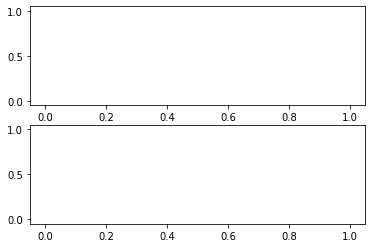[1]:
import matplotlib.pyplot as plt
%matplotlib inline
[2]:
from controlgame import ControlGame
[3]:
game = ControlGame(runtime=30) # seconds
1. Instructions
Run the cell below and click the “run” button. Then move the “MV” slider in a way which gets the controlled slider close to the setpoint. Your score increases more quickly when Controlled is near Setpoint. See how high your score can get by clicking run a couple of times. To see your performance graphed out, execute the next cell (game.plot())
[4]:
game.ui()
[5]:
game.plot()

[6]:
import scipy.signal
[7]:
ts = game.ts
[8]:
G = scipy.signal.lti(2, [2, 0])
[9]:
import numpy
[10]:
LIMIT = 100
[11]:
def score(ts, sps, cvs):
scores = 1 - numpy.minimum(numpy.abs(numpy.array(sps) - numpy.array(cvs)), LIMIT)/LIMIT
score = sum(scores)
return score
[12]:
def sim(ts, mvs):
_, cvs, _ = scipy.signal.lsim(G, mvs, ts)
return cvs
[13]:
def objective(mvs):
return -score(game.ts, game.sps, sim(game.ts, mvs))
[15]:
objective(game.mvs)
---------------------------------------------------------------------------
IndexError Traceback (most recent call last)
<ipython-input-15-c61c532d40ad> in <module>
----> 1 objective(game.mvs)
<ipython-input-13-96e53751337c> in objective(mvs)
1 def objective(mvs):
----> 2 return -score(game.ts, game.sps, sim(game.ts, mvs))
<ipython-input-12-d6eb717acf80> in sim(ts, mvs)
1 def sim(ts, mvs):
----> 2 _, cvs, _ = scipy.signal.lsim(G, mvs, ts)
3
4 return cvs
~/anaconda3/lib/python3.7/site-packages/scipy/signal/ltisys.py in lsim(system, U, T, X0, interp)
1944 xout = zeros((n_steps, n_states), sys.A.dtype)
1945
-> 1946 if T[0] == 0:
1947 xout[0] = X0
1948 elif T[0] > 0:
IndexError: index 0 is out of bounds for axis 0 with size 0
[ ]:
[ ]:
import scipy.optimize
[ ]:
guesses = 1
[ ]:
bestmvs = game.mvs
for i in range(guesses):
sol = scipy.optimize.minimize(objective, bestmvs + 2*(numpy.random.rand(len(bestmvs))*2-1), bounds=[(-LIMIT, LIMIT)]*len(game.mvs))
print('Score:', -sol.fun)
bestmvs = sol.x
bestmvs[numpy.abs(bestmvs)<10] = 0
[ ]:
bestcvs = sim(ts, bestmvs)
[ ]:
fig, (axmv, axcv) = plt.subplots(2, 1)
axmv.plot(ts, bestmvs)
axcv.plot(ts, game.sps, ts, bestcvs)